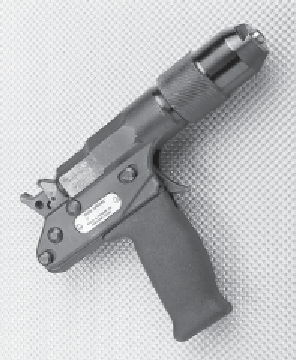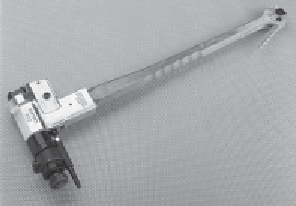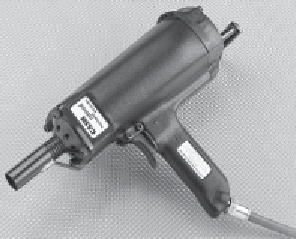Agriculture Reference
In-Depth Information
(a)
(b)
(d)
(c)
(f)
(e)
Figure 7.1
Various types of percussive stunners. (a) Penetrative percussion stunner; incorporates special 'no fire' system with low noise
level. (b) Contact firing penetrative concussive stunner available for large and small animals. (c) Air-powered penetrative stunner for
sheep and goats; contact and 'no-fire' systems incorporated. (d) Penetrative concussive stunner 0.22 calibre; palm- or finger-activated
trigger; firing pin pull to cock instrument. (e) Contact and failsafe non-penetrative concussive stunner for use in deep stunning pens;
suitable for ritual slaughter. (f) Non-penetrative concussive stunner incorporating 'no-fire' system; suitable for ritual slaughter (by kind
permission of Messrs Accles and Shelvoke, Witton, www.acclesandshlevoke.co.uk).
bolt, which is heavily dependent on the speed at which it
strikes the brain, rather than the penetration of the brain
per se
. A velocity of about 55 m/s is recommended for
steers, heifers and cows, and between 65 and 70 m/s for
young bulls. The strength of the cartridge must be
matched with the robustness of the gun to prevent metal
fatigue and breaks in washers, buffers, etc.
Percussive stunners achieve their effect as a result of
the energy imparted to the brain generating turbulent
lambs, up to 3 and 4 grains for large cattle and mature
bulls (1 grain = 0.065 g).
Properly used, captive bolt equipment is very effective
in finished cattle, sheep and calves, but less so in bulls
and pigs, especially sows and boars, in which the frontal
bone structure is very thick and restraint to allow accu-
rate application is difficult (Fig. 7.1).
The important force in producing unconsciousness
with the captive bolt pistol is the impact energy of the






